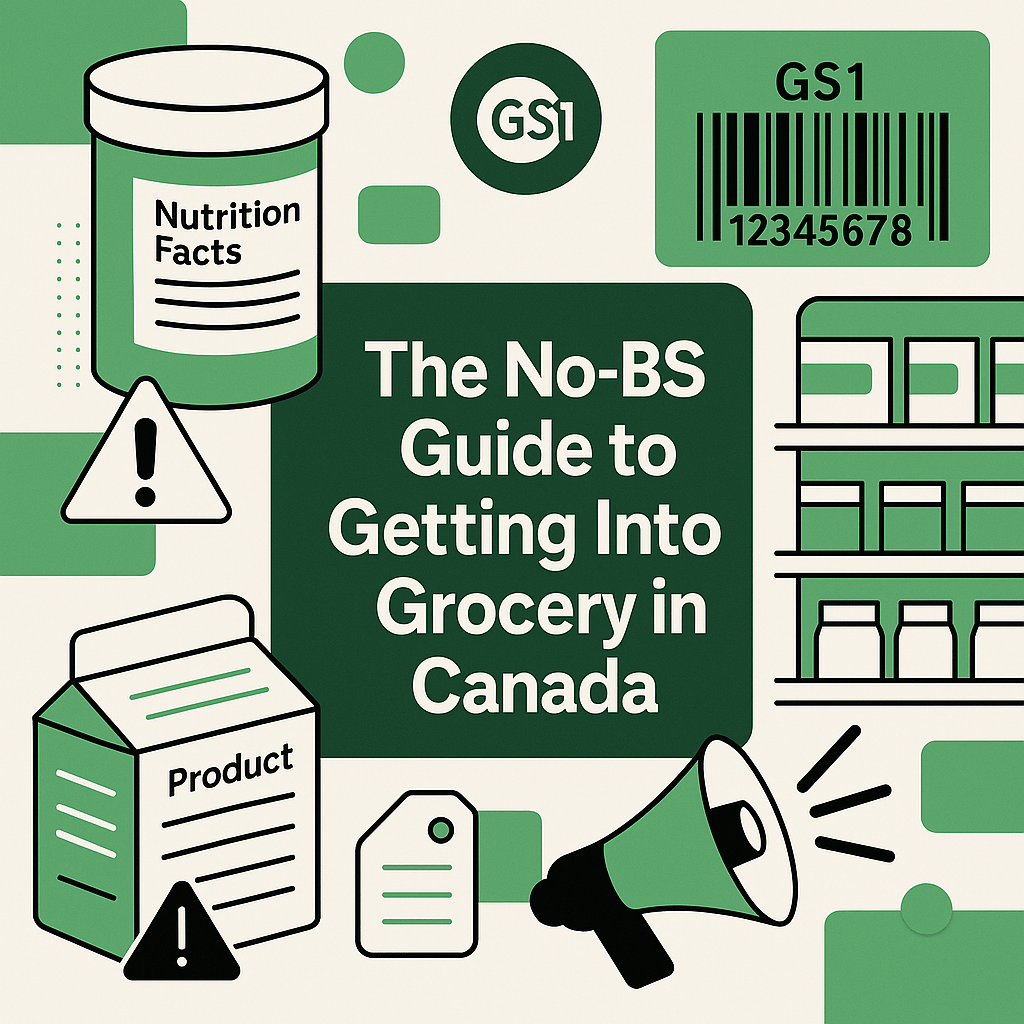(And why most people underestimate how hard it is)
If you’ve ever thought, “Our food product belongs on grocery shelves,” you’re probably right. But getting there? That’s a whole different game.
The Canadian grocery landscape is a beast—layers of regulation, compliance hurdles, and gatekeepers between you and shelf space. We’ve built this step-by-step guide to help you avoid the common traps (and save thousands of dollars in mistakes).
Here’s how to do it—step-by-step.
Step 1: Label Compliance – CFIA or Bust
Before a buyer even looks at your product, your label needs to pass CFIA (Canadian Food Inspection Agency) requirements. It’s a non-negotiable for all major grocers and retailers:
What You’ll Need:
- A CFIA-compliant bilingual label (English and French)
- Nutrition Facts Table (NFT) that follows Canadian formatting rules
- Ingredient list + allergen declarations
- Expiry/best-before date formats
- Font sizes, placement, layout requirements
- New FOPL (Front-of-Package Labeling) rules for high sodium, sugar, and fat
Action Steps:
- Hire a label compliance consultant (if you’re new—this isn’t DIY).
- Ballpark cost: $1,500–$5,000 per product label
- Run a full nutritional analysis through a certified lab if you don’t have one already.
- Cost: $600–$1,200 per SKU
- Ensure bilingual compliance: labels must be fully in English and French.
- Review CFIA’s Industry Labelling Tool: CFIA Labelling Tool
Pro Tip:
FOPL (those warning symbols) is the new gatekeeper. One wrong macro ratio and your label needs a redesign.
Step 2: Get GS1 Certified & Barcode Your SKUs
You need a globally unique barcode for every product you plan to sell. Retailers require it. The only legit source in Canada is GS1 Canada.
Action Steps:
- Register for a GS1 Company Prefix:
- Start here: https://gs1ca.org
- Choose your plan based on how many products/SKUs you need to barcode.
- Starter plan (up to 10 barcodes): ~$250 CAD/year
- Larger plans (up to 100 barcodes): ~$750–$2,500 CAD/year
- Generate and assign barcodes using the GS1 portal.
- Print or apply barcodes to packaging using a GS1-verified format.
Pro Tip:
You must own your barcodes. Do not buy cheap third-party codes—they’ll get flagged by retailers and you’ll be blacklisted before you start.
Step 3: Line Up Your Distribution & Brokers
Retailers won’t work directly with most small producers. You’ll need distributors (to get product into warehouses) and brokers (to get you listed).
Action Steps:
- Build a distributor shortlist in your target region (ex: UNFI, Horizon, Neal Brothers).
- Pitch your product to brokers who specialize in your category.
- Expect commission: ~5–7% of sales (some charge monthly retainers too)
- Create a sell sheet: includes CFIA-compliant label, pricing, margin, case pack, and shelf life.
- Prepare for slotting fees if you’re targeting national chains.
- Slotting fees can range from $5,000–$25,000 per SKU per region.
Pro Tip:
Distributors and brokers care about your margin. If your product can’t offer a 30–40% margin to retail after distribution, you need to revisit pricing.
Step 4: Marketing to Grocery Retailers (and Their Shoppers)
Now that you’ve secured shelf space, you need to earn it. If your product doesn’t move, it won’t stay.
Action Steps:
- Create a marketing plan with launch promos, discounts, and in-store signage.
- Support in-store demos (where allowed) or digital coupons via platforms like Flipp.
- Run co-branded campaigns with your retailers—this builds goodwill and sales.
- Track your velocity (units per SKU per store per week) and keep buyers updated.
Pro Tip:
Even regional retailers want to know how you’ll support their sales. No plan = no listing, or a very short-lived one.
Why Most Brands Get Stuck Here
Every one of these steps costs time, money, and precision. One misstep in CFIA compliance, and your label gets rejected, potentially requiring a costly re-print. One incorrect barcode, and your product doesn’t scan. One slow sales cycle, and your SKU gets dropped.
That’s why we built UpMeals OS.
Our platform:
- Automates CFIA-compliant label creation (yes, even FOPL and bilingual formatting)
- Manages GS1 barcode integration
- Centralizes SKU data, logistics, and sell sheets
- Helps you launch, track, and scale your retail presence
No spreadsheets. No guesswork. Just a smarter way to grow.
Getting into grocery isn’t easy.
But with the right tools, it doesn’t have to be a scary process either.
👉 Book a demo of UpMeals OS and see how we make retail-ready look easy.





